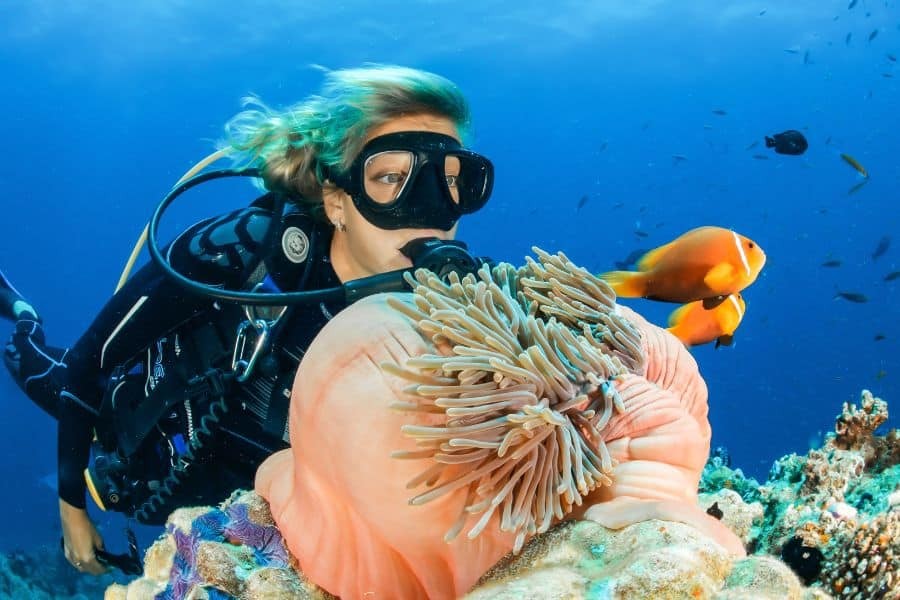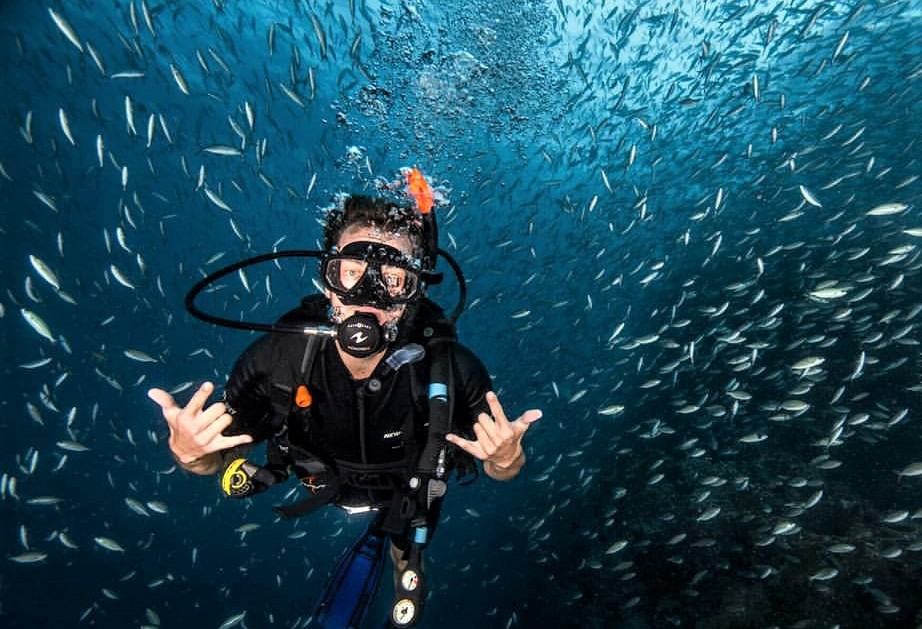Diving Sites in Port Blair







At some point, a scuba diver needs to have a better understanding of the local ecosystem along with the differences between aquatic and terrestrial worlds. With this, you will be able to see new things even in the most common and familiar dive sites. By taking the PADI Underwater Naturalist Speciality course, you will spot new things even in the most usual scuba diving sites.
You will be able to notice behaviours and spot creatures that you may have missed earlier as by taking this diving course, you will know more about symbioses, underwater ecology, as well as aquatic plant and animal habitats. The PADI course will let you learn about the local ecosystem and take a closer look into the incredible underwater world.
Download Medical FormAcademic
There will be class discussions and 2 scuba dives under the PADI Underwater Naturalist course. You will learn the following:
- Responsible interactions with aquatic life
- Key differences between the terrestrial and aquatic worlds
- Major aquatic life groupings, interactions, and information that dispels myths
- Role of aquatic plants, food chains and predator/prey relationships
- Underwater naturalist’s view of organisms and their roles in the environment
Best Places to Scuba Dive in the Andaman Islands
There are more than 40 places to dive into this Indian union territory. Various factors that influence the perfect diving experience are as follows:
- Safety
- Weather
- Water depth
- Water current
- Fish population
- Clarity of water
- Population of corals
Keeping all these things in mind while picking up a place for your dive can be a little bit tough. Isn’t it? But don’t worry, we present here the list of best places for scuba diving in the Andamans:
- Havelock Island (the most preferred one)
- North Bay Island
- Neil Island
- Port Blair
The first dive of this PADI Specialty Diver course may be considered an Adventure Dive toward your Advanced Open Water Diver certification. You can ask our instructor about this in detail.
For both new and experienced divers, Havelock Island ensures a memorable diving experience as it is among the best places for scuba diving in the Andaman Islands. Second to none, its rich marine life and coral population offers a great experience. When you are under the water, vibrant and colourful fish often surrounds you. That feeling cannot be explained in words. Here, your dive is absolutely safe and stress-free as the beach has a perfect blend of clear waters and low water currents.
Understand the Ocean Better – Start Today
Equipment
A slate and pencil will be needed for recording your observations along with your basic scuba gear. You may also require a dive light in order to better see into cracks and crevices.
In Havelock Island, you can indulge yourself in the fascinating activity of scuba diving and make your trip unforgettable. The dives are conducted preferably early in the morning because of clear visibility and increased chances of finding breathing corals during that time of the day. Complete assistance is given by the PADI (Professional Association of Diving Instructors) certified scuba instructor. He would brief you about the “dos and don’ts” of scuba diving.
Things to Carry for Scuba Diving
- Towel
- Water bottle
- Extra set of clothes
- Personal medicine kit, if needed
Getting Started
To get all the details and to begin the PADI Underwater Naturalist course, contact our dive centre, which is a 5-star PADI facility located in Havelock Island (now known as Swaraj Dweep). You can plan your underwater naturalist dives with our expert divers.
Top Diving Sites in Havelock Island
Havelock Island is known for many outstanding locations that are great spots for diving. Going under the depths of these waters is exactly the type of experience that you are looking for.
Barracuda City
For beginners, this is simply the best spot for diving. It is completely different from other locations as you can see long strips of coral belts with the perfect blend of hard as well as soft coral population. Its rich ecosystem offers tons of fish of diverse species and colors. And if you are lucky enough, then you can spot wandering sea turtles near the corals. If you are seeking a highly unique and terrific experience, then Barracuda City is the perfect spot for you.
Seduction Point
A huge underwater rock displaying an ample range of marine life is what describes this hilly underwater world the best. Divers looking for something exclusive should know that this is a perfect diving spot in Havelock Island owing to the shallow water, a large number of inhabitants including Napoleons, and a dense population of hard staghorn corals.
Aquarium
Promising a lot to beginners, this spot is a bit offshore at a distance of three kilometres from Elephant Beach. It houses fringing reefs that are crowded with large groups of colourful fishes. You can see hard corals here in its clear water which is perfect for a good view of marine life.
Minerva Ledge
It is simply described as an enormous block of hard corals in clear waters, with sea dwellers including sharks. The site is only recommended for experienced divers. It promises a rare glimpse of the underwater kingdom along with an enthralling diving experience.
Lighthouse
If you want to witness the perfect balance of vibrant fish and soft & hard corals, then this is your one-stop destination. The water is shallow but gets deeper as you move farther from the shore. You can dive here at night also since the water clarity is great here.
Other top Scuba Diving Sites in Havelock Island
- Jonny George
- Dicksons Pinnacle
- MV Mars
- The Slope
Scuba diving is all about what you see under the water. Immersing in the big blue means going into a world that is home to fascinating creatures, plants, and breath-taking landscapes. Everyone appreciates the beauty beneath the surface. However, admiring the functioning of the underwater environment on a more complex level is something that is sure to enhance your diving adventures in different unexpected ways.
You will be able to savour the sights you encounter on your dives when you have a better understanding of the aquatic world. By taking the PADI Underwater Naturalist course, you will go beyond simply recognizing the occasional fish. You will be taught to identify fish, plants, and animals. In this course, you will also learn how their interactions affect each other and the environment.
There will be two open water dives in which you will be applying the course information to a real-world diving situation. You will be able to understand the behaviour of different species that earlier you haven’t even noticed. It is like being surrounded by creatures whose behaviour you already know.
It’s very obvious for you to feel enthusiastic about conservation if you are passionate about scuba diving. The PADI Underwater Naturalist course is a great way to start your journey toward becoming an underwater conservationist. This knowledge will be forever and it will give you more joy during your diving adventures. You will be a stronger advocate for underwater life for sure.
Frequently Asked Questions
-
Q. 1 : What is the PADI Underwater Naturalist course?
The PADI Underwater Naturalist course is a specialty diving course offered by the Professional Association of Diving Instructors (PADI) that focuses on the ecology and conservation of the underwater world. The course teaches divers how to identify and classify different marine species, understand their behavior and habitats, and recognize the different ecosystems that make up the underwater environment.
-
Q. 2 : What are the prerequisites for the PADI Underwater Naturalist course?
The prerequisites for the PADI Underwater Naturalist course are that you must be at least 10 years old, have a PADI Open Water Diver certification or equivalent, and be in good physical health.
-
Q. 3 : Where can I take the PADI Underwater Naturalist course in India?
The PADI Underwater Naturalist course is offered by several PADI dive centers and resorts throughout India, including in popular diving destinations such as the Andaman and Nicobar Islands, Goa, and Lakshadweep. You can search for PADI dive centers in your area on the PADI website.
-
Q. 4 : How long does the PADI Underwater Naturalist course take?
The PADI Underwater Naturalist course typically takes 2-3 days to complete, depending on the dive center and the specific course schedule.
-
Q. 5 : What will I learn in the PADI Underwater Naturalist course?
In the PADI Underwater Naturalist course, you will learn about the different marine ecosystems and habitats, how to identify different marine species and their behavior, and the importance of conservation and preservation efforts in protecting the underwater environment. The course may also cover topics such as coral reef ecology, marine life adaptations, and marine biodiversity.
-
Q. 6 : What are the skills required for the PADI Underwater Naturalist course?
The skills required for the PADI Underwater Naturalist course include the ability to identify different marine species based on their physical characteristics and behavior, the ability to recognize different marine ecosystems and habitats, and an understanding of the importance of conservation and preservation efforts.
-
Q. 7 : What are the benefits of taking the PADI Underwater Naturalist course?
The benefits of taking the PADI Underwater Naturalist course include a deeper understanding and appreciation of the underwater world, the ability to identify and classify different marine species, and the knowledge to make informed decisions regarding conservation and preservation efforts. The course can also enhance your overall diving experience by providing a greater understanding of the underwater environment.
-
Q. 8 : What are the career opportunities available for individuals certified with PADI Underwater Naturalist?
While the PADI Underwater Naturalist course is primarily a recreational diving course, the knowledge and skills gained from the course can be beneficial for careers in marine biology, marine conservation, and environmental science. Additionally, dive centers and resorts may seek out PADI Underwater Naturalist instructors or dive guides to lead eco-tourism and conservation efforts.
-
Q. 9 : What is the cost of the PADI Underwater Naturalist course in India?
The cost of the PADI Underwater Naturalist course may vary depending on the dive center and the specific course schedule. However, the course typically costs between INR 10,000 to INR 15,000 in India.
-
Q. 10 : Who can take the PADI Underwater Naturalist Course?
Anyone who is at least 10 years old and has a PADI Open Water Diver certification or equivalent can take the PADI Underwater Naturalist Course.
-
Q. 11 : Where can I take the PADI Underwater Naturalist Course in India?
The PADI Underwater Naturalist Course is offered at various PADI dive centers and resorts throughout India.
-
Q. 12 : How many dives will I make during the PADI Underwater Naturalist Course?
You will make two open water dives during the PADI Underwater Naturalist Course.
-
Q. 13 : What is the certification process for the PADI Underwater Naturalist Course?
Upon completion of the course, you will receive a PADI Underwater Naturalist certification card.
-
Q. 14 : Can I take the PADI Underwater Naturalist Course online?
Yes, you can take the PADI Underwater Naturalist Course online through the PADI eLearning platform.
-
Q. 15 : Can I take the PADI Underwater Naturalist Course if I have a medical condition?
If you have a medical condition, you will need to consult with a physician before taking the PADI Underwater Naturalist Course. You may need to provide a medical clearance form before diving.
-
Q. 16 : What is the maximum depth for the PADI Underwater Naturalist Course?
The maximum depth for the PADI Underwater Naturalist Course is 18 meters/60 feet.
-
Q. 17 : What is the difference between the PADI Underwater Naturalist Course and other scuba diving courses?
The PADI Underwater Naturalist Course focuses specifically on the underwater environment and marine life, while other scuba diving courses cover more general diving skills and techniques.
-
Q. 18 : Is the PADI Underwater Naturalist Course difficult?
The difficulty of the PADI Underwater Naturalist Course depends on your level of experience and comfort in the water. However, the course is designed to be accessible for beginner and intermediate divers.
-
Q. 19 : What are the career opportunities after completing the PADI Underwater Naturalist Course?
The PADI Underwater Naturalist Course can be a valuable addition to your scuba diving resume, and may open up opportunities for further training and certifications in marine biology or conservation.
-
Q. 20 : Is the PADI Underwater Naturalist Course recognized internationally?
Yes, the PADI Underwater Naturalist Course is recognized by diving organizations and operators worldwide.
-
Q. 21 : What if I don't have my own scuba diving gear for the PADI Underwater Naturalist Course?
Many dive centers and resorts offer rental gear for the course. However, it is recommended that you have your own gear for optimal comfort and familiarity.
-
Q. 22 : Can I take the PADI Underwater Naturalist Course with a group or private instructor?
Both options are available, depending on the dive center or instructor. Group courses may be more affordable, while private instruction can provide more personalized attention and flexibility in scheduling.
-
Q. 23 : Can I take the PADI Underwater Naturalist Course if I am not a strong swimmer?
While basic swimming skills are necessary for scuba diving, you do not need to be an expert swimmer to take the PADI Underwater Naturalist Course. However, it is recommended that you feel comfortable and confident in the water.
Diving Sites in Port Blair
Diving Sites in Havelock Island
Diving Sites in Neil Island
Talk to our Scuba Diving Expert
X